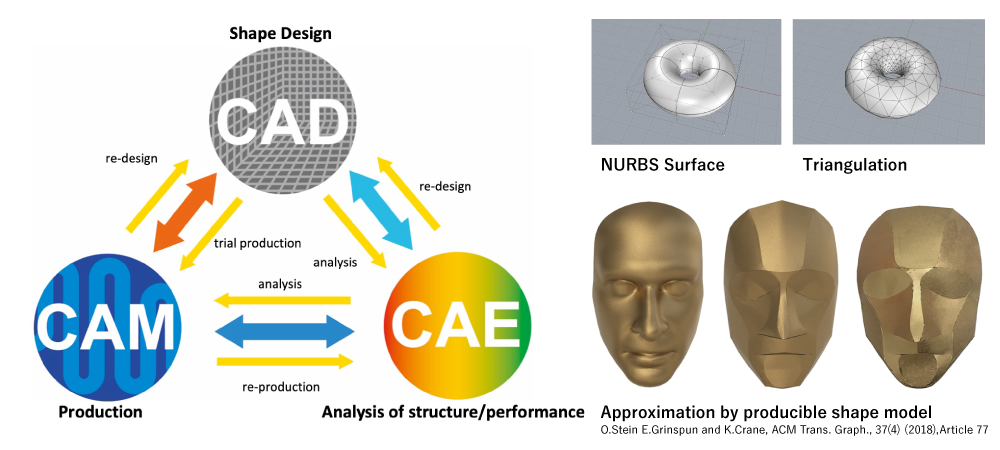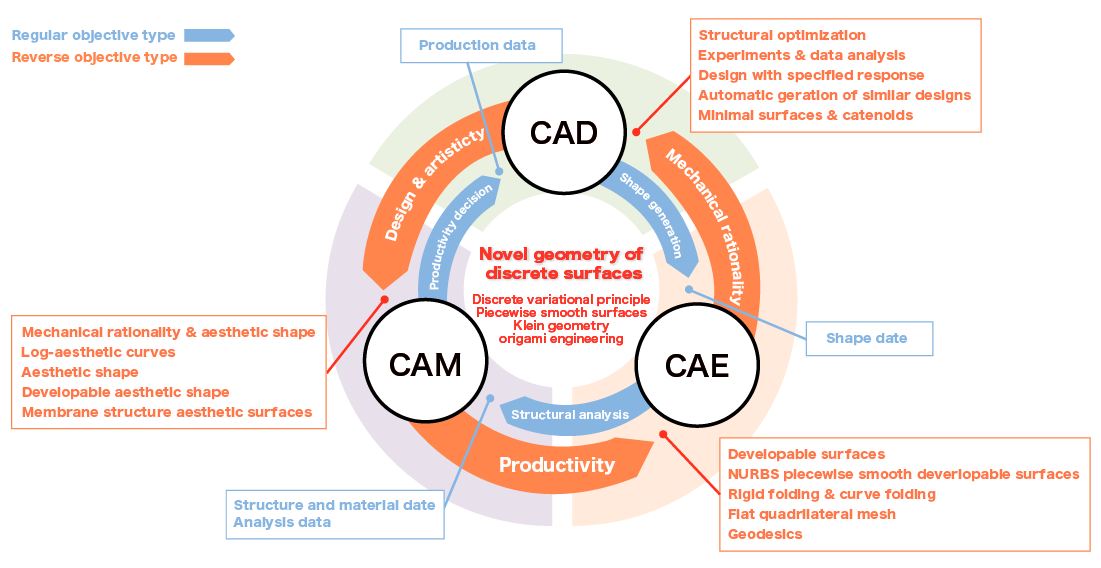Research Overview
CREST-ED3GE: Evolving Design and Discrete Differential GEometry - towards Mathematics Aided Geometric Design
- Overview
- Social Backround of the Project
- Aim of the Project
- Contribution to CREST research area and impact on science and technology
Overview
By developing advanced machine tools based on the art of artisans, Japanese manufacturing has grown to be the world level. However, due to such success, so to speak, Japan fell behind in recognition of the importance of software to bring out the power of human resources and hardware. This led to the high cost together with the employment cost, and therefore to the decline of international competitiveness. This tendency is noticeable in the area of design.
In this research project, we develop a platform that brings about innovation to design and production widely based on mathematics and information science. This project enables structural design with high efficiency and low cost, endowed with beauty and artisticity, and guaranteeing security and safety. We organize a mixed team with various areas of design based on an intimate collaboration of the experts in mathematics and information science. Then we extract common problems in design and production, give mathematical formulation, and implement the software for practical use. The uniqueness of this research project lies in the comprehensive activities from theory to practice.
From large structures such as buildings, ships, aircraft, and cars to furniture, home appliances, and package materials, all the shapes are designed so that they satisfy various specifications and restrictions as well as the beauty of their appearance. While each area of design has its own know-how independently, there are gaps of knowledge due to the lack of a common framework. As mathematics to extract the common problems among the areas, we take “Geometry of discrete surfaces with the developable surfaces as the shape elements, and its discrete variational principle.” In the production of the structures from the plate-like materials such as metals, geometry with the shape elements given by the developable surfaces, which are surfaces with the zero Gaussian curvature provides a natural framework. By developing the “theory of aesthetic shapes” in this framework, which has been studied by the group including the leader of this project, we present a design paradigm that enables the physical restrictions compatible with the artisticity. We construct the theory and method of structural analysis and optimization to develop an innovative software platform on the novel discrete geometry that is widely applicable. The final goal is to give a rebirth to the Japanese manufacturing which creates precise and beautiful products but with currently high cost with the power of the mathematical capitalism, by integrating the knowledge in various areas of design to the geometry of shapes by the power of mathematics.
Social Backround of the Project
It is an urgent task for the rebirth of Japanese manufacturing to improve the efficiency and lower the cost, together with the improvement of the quality of design and safety. In the discussions towards this project among the possible members, the following issues were extracted. Now, the mainstream in the design area is the shape design with the standard model based on the NURBS (non-uniform rational B-spline) surface. A typical process may be described as (a) approximation of shapes by the standard model of the NURBS surface (b) structural analysis with the approximation by the polygons (c) sending to the production process after the approximation by the shape models suitable for the practical production (such as developable surfaces). In this process, the following issues arise:

- The NUBS surfaces do not reflect the properties originating from the materials, and so they are not suitable for the design whose final goal is the production of the structures. This is a factor in the high cost of manufacturing.
- The design of highly artistic shapes by the NURBS surfaces requires the high skill of the designers. Also, in the current design process, the designers tend to wither due to the potential restrictions originating from the required specifications, so that creativity is restricted.
- Currently, each process of (a), (b), and (c) uses different shape models, which results in degradation of the quality and safety due to the approximations during the transformations of the models. It also leads to low efficiency due to the restriction of correspondence between the processes.
Also, the following issue is a serious problem. - In the area of design, various techniques have been developed to deal with the shapes according to the character of each area of the design objects. However, those are not well shared because of the lack of a common platform.
Aim of the Project
In this project, we focus on the wide range of design such as architecture, shipbuilding, and industrial design, to develop an innovative “bidirectional circulative design platform” that overcome the above issues, and that enables structural design with high efficiency and low cost, endowed with beauty and artisticity, and guaranteeing security and safety. As the theoretical basis to deal with various mathematical problems comprehensively for the achievement of the purpose of the project, we originate a novel geometry of discrete surfaces having the surfaces with good properties as the shape elements and discrete variational principle. In particular, in view of the restriction from the production of the structures in the design of architecture and ships, we mainly focus on the geometry with the developable surfaces as the shape elements and incorporate the theory of aesthetic shapes developed in the area of industrial design. We integrate discrete differential geometry and the technique to deal with the developable surfaces in the computational geometry which has been developed by the needs of recent origami design, and to sublimate it to the universal geometry of shapes that is applicable to a wide range of design. Based on this theoretical framework, we construct an innovative software platform that directly enables the design of shapes endowed with mechanical rationality and superior productivity and with good geometric properties. Namely, the purpose of this research project is described as follows.
To re-integrate the knowledge accumulated in the various areas of design with mathematics as a hub, and to create an innovative design paradigm based on a novel “geometry of shapes” subsuming the knowledge by the collaboration of mathematics and computational geometry.
The above research will solve the problems (i)-(iv) as follows. The results will provide a basis for the rebirth of Japanese manufacturing which creates precise and beautiful products but with currently high cost with the power of the mathematical capitalism.

- Adopting the developable surfaces that can be made by bending the materials such as the metal plate as the shape elements, it is possible to design the shapes that can be sent directly to the production process. This realizes drastic improvement in the efficiency of design - > analysis - > improvement cycle and lowering the cost.
- Incorporating the theory of aesthetic shapes enables the design of shapes with beauty and aestheticity remarkably easier. Also, by defining the notion of discrete curvature on the discrete surfaces appropriately, and by introducing the distance between the surfaces, it is possible to quantify and predict the differences of structural stability and productivity. Combining the discrete variational principle and structural analysis makes the optimization of the properties such as the mechanical rigidity, which realizes the design of aesthetic shapes with security and safety. Then it enables the design and analysis on a certain class of surfaces that meets the requirements of design according to the restrictions arising from the materials and structures. Such “inverse purpose type” software realizes the bidirectional circulative design platform, which drastically improves the efficiency and creativity of design, and quality and safety of the structure.
- Since we construct the method of analysis based on the theory of discrete surfaces, not on the discretization of the smooth surfaces as the approximation, it is possible to utilize the measurement data efficiently. Data import, design, analysis, simulation, and visualization can be carried out in one platform without degrading the quality.
- The collaboration of computational geometry, mathematics, and design enables the efficient design of artistic shapes and the utilization of shape generation technology by the developable surfaces in a wide range of areas. For example, the design of new membrane structure and the shell structure become easy, such as temporal structures with high portability and robustness and with beautiful appearance used in the disasters.
Theoretically, the research corresponds to constructing the framework that generalizes emerging discrete differential geometry which constitutes the discrete surfaces by using the quadrilateral on a plane as the shape elements. Thus, the research is highly new and challenging.
Contribution to CREST research area and impact on science and technology
This project can comply with three goals of CREST research area “Mathematical Information Platform” in the following manner.
- Construction of the theory and technology that contribute to the creation of a new information utilization method involving the concept of mathematics
- Creation of a new science that links mathematics, mathematical science, and information science
- Creation of a next-generation application platform technology of data analysis algorithms and software programs that accelerates and enhances the utilization of information in various fields and the industrial world
Incorporating the technique of (discrete) differential geometry to that for developable surfaces developed in the computational geometry and the origami engineering, we construct a novel and widely applicable theoretical framework and an innovative software platform based on it. This creates a new science that links information science and mathematics based on the geometry of shapes. Definition of a class of surfaces with designability, analyticity and controllable singularity, contruction of the analysis method such as analysis of flows and discrete variational principle on such surfaces, dynamical analysis could be listed as the mathematical challenges. For these challenges, a new research area that integrates discrete differential geometry, global analysis, real algebraic geometry and computational science will be created.
We replace the existing standard technology and its mathematical basis by those directly used in the design so that it remarkably improves the quality and efficiency of design. Also, direct processing of the imported measurement and experiment data provides a basis for the integrated platform of the experiment, simulation, and design.
This research project creates a new geometry of discrete shapes and forms a frontier over geometry, analysis, discrete mathematics, and computational geometry. In the practical aspect, the design of structures with high artisticity and safety will become possible with low cost and high efficiency. It brings out innovation to the area of design and activates manufacturing.


 Return to Top Page
Return to Top Page